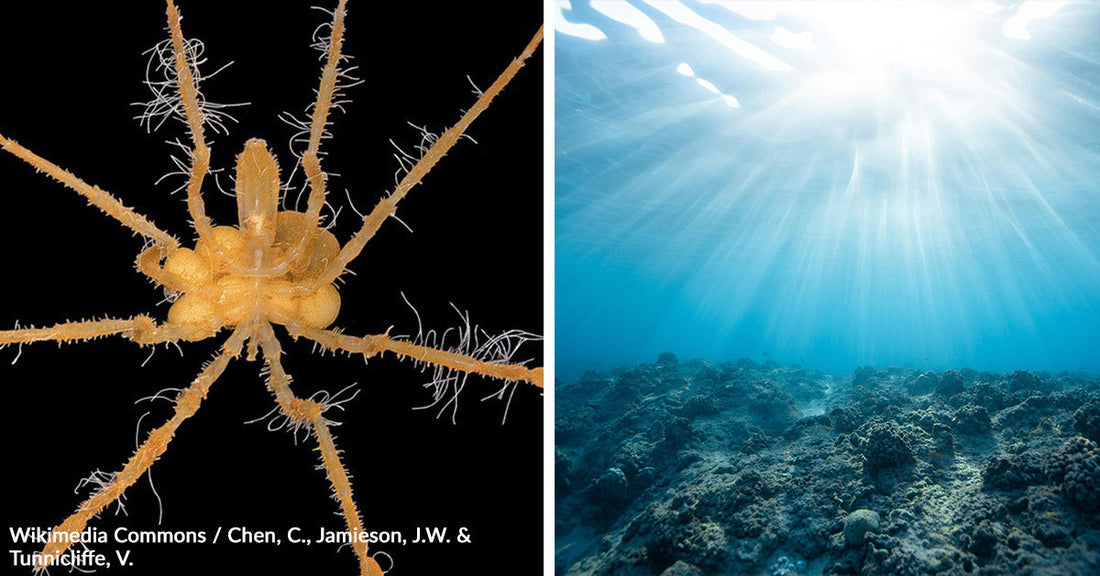7th Annual Holiday Toy & Book Event Help make the holidays brighter this year!
Scientists Find Deep-Sea Spiders Farming Microbes That Could Trap Climate Gas
Matthew Russell
In the frigid, pitch-black waters off the coasts of Southern California and Alaska, scientists have discovered something both alien and astonishing: sea spiders that survive not by hunting prey, but by harvesting bacteria that live on their own bodies.
These newly identified species from the Sericosura genus are the first sea spiders known to consume methane-eating microbes as a primary food source—an evolutionary feat that’s turning heads far beyond marine biology.
The research team, led by Occidental College biologist Shana Goffredi, collected these creatures from methane seeps—submarine vents where methane gas leaks up from the seafloor. Rather than scavenge or hunt, these translucent arachnids graze their exoskeletons for sustenance, where microbial colonies feast on methane and convert it into energy-rich sugars and fats. It’s a farming system built into their skin, CNN reports.

Photo: Wikimedia Commons / Chen, C., Jamieson, J.W. & Tunnicliffe, V., License: CC BY 4.0
Sea spiders have been found farming bacteria on their own bodies.
Body-Bound Bacteria and the Methane Menu
These methane seeps create chemical oases in the deep sea, where sunlight never reaches and photosynthesis is impossible. Instead, microbes rely on chemosynthesis, using methane as fuel. According to Phys.org, the bacteria coating the sea spiders belong to families like Methylomonadaceae, Methylophagaceae, and Methylophilaceae. Once anchored to the spider’s body, they turn methane into digestible compounds. The spiders, in turn, use their tiny appendages to scrape the bacteria off and consume them.
Goffredi’s team confirmed the methane-derived diet by tracking isotopes in spider tissues. After placing live specimens in seawater laced with heavy-carbon methane (¹³C), they detected the isotope inside the spiders’ gut lining—clear proof that carbon was making its way from gas to bacteria to arachnid.

Photo: Wikimedia Commons / Chen, C., Jamieson, J.W. & Tunnicliffe, V., License: CC BY 4.0
The spiders lack traditional hunting appendages.
Survival Without Sunlight
Unlike their land-based cousins, these deep-sea spiders lack the fangs necessary for predation. That evolutionary gap opened the door for a new form of feeding. They’ve adapted to their low-energy world by turning into mobile microbial farms. Their exoskeletons host structured bacterial colonies embedded in a sticky biofilm. These microbial mats even show signs of disturbance—evidence of regular grazing, Interesting Engineering reports.
The phenomenon is reminiscent of the deep-sea yeti crab, which cultivates sulfur bacteria on its claws. But sea spiders represent a first for methane-based symbiosis in arthropods. It’s not just a curiosity; it’s a shift in our understanding of how animals harness microbial energy in some of Earth’s most extreme environments.

These spiders could play a role in global carbon cycling.
A Next Generation Fueled by Microbes
Even more remarkable is how this symbiosis may be passed from one generation to the next. According to SFGate, male spiders, who carry hundreds of eggs in bundles wrapped around their legs, also carry the same methane-eating bacteria. When hatchlings emerge, they appear to inherit these microbial allies, giving them an instant food source in the barren deep sea.
The researchers found these spiders in three distinct regions: the Del Mar and Palos Verdes seeps off Southern California, and the Sanak seep off Alaska. Their limited range suggests that populations are highly localized, which could make them particularly vulnerable to environmental disruptions. Despite their small size—just a centimeter long—their role in the methane cycle could be anything but small.
Keeping Climate Gas Underground
Methane is a potent greenhouse gas. What happens to it in the ocean matters for the entire planet. These sea spiders and their microbial passengers may serve a hidden role in capturing methane before it rises into the water column or escapes into the atmosphere. As IFLScience reports, their microbial symbionts could one day inspire methane mitigation strategies in contaminated waterways closer to home.
For now, though, they remain a stunning example of how life finds a way—even in the most lightless, high-pressure corners of Earth. Their discovery also acts as a quiet reminder: deep-sea ecosystems are rich, fragile, and full of surprises we’ve only just begun to understand.

